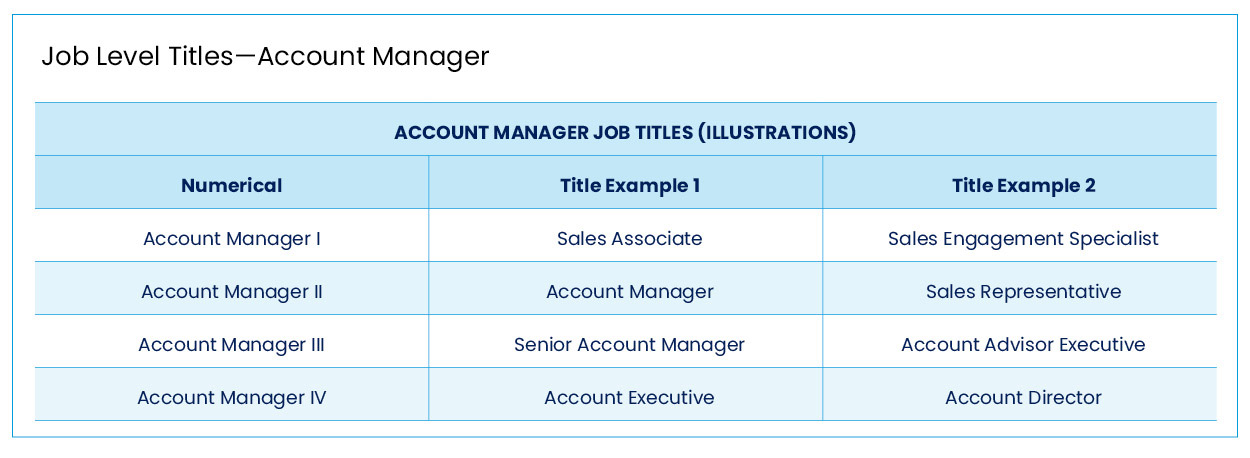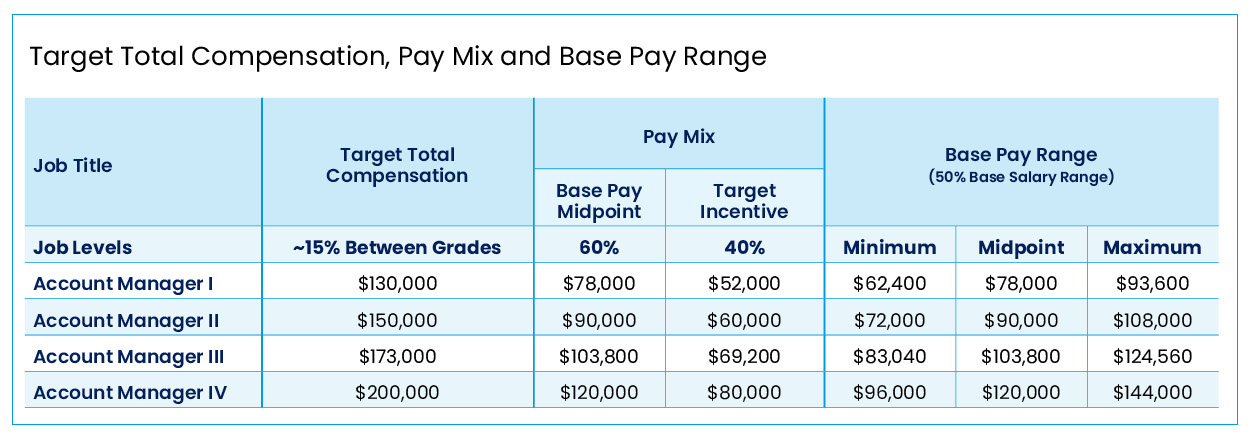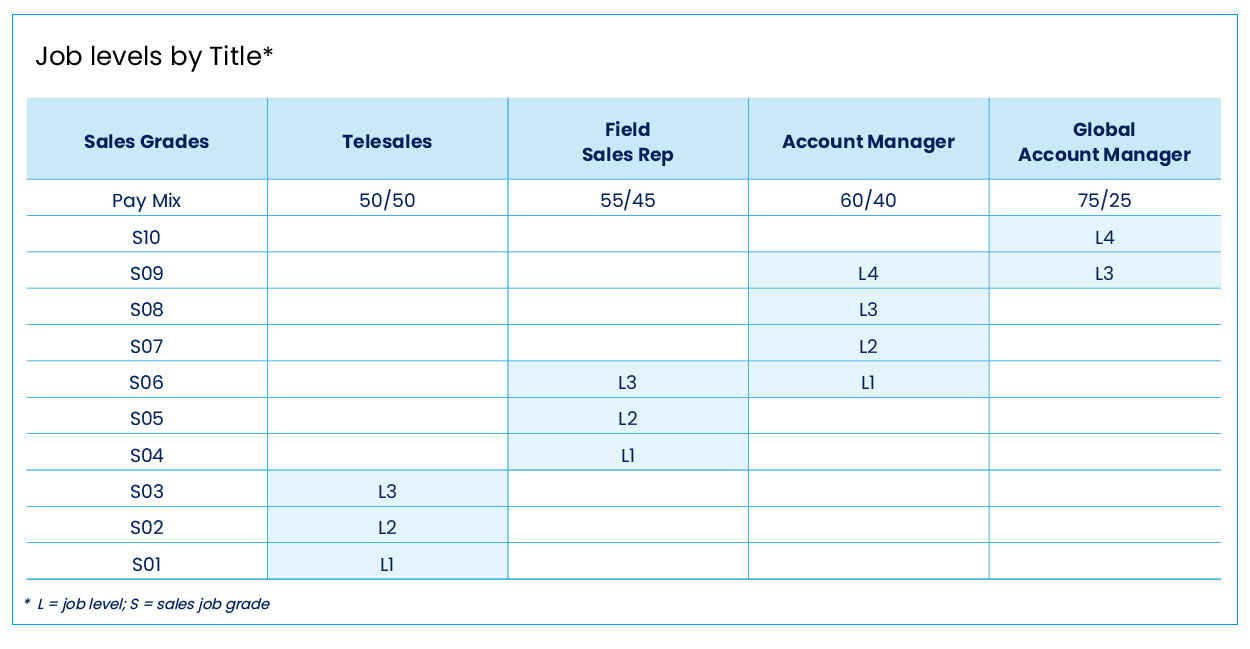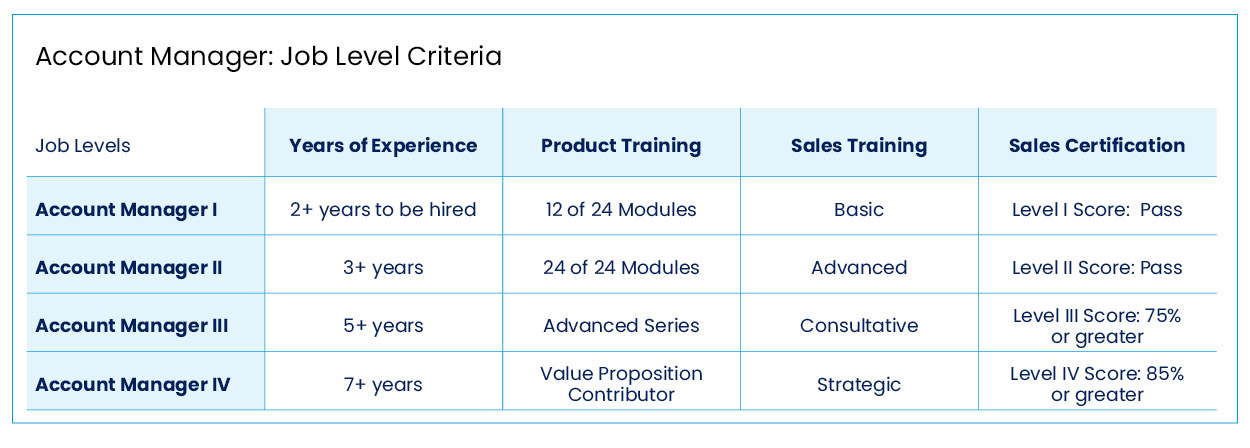- Foster excellence with job levels. Sales compensation stakeholders can use job levels to foster excellence among the company’s sales talent.
- Different pay opportunities. Job levels provide different pay opportunities for incumbents performing the same job but reflecting different competency levels. Entry-level folks are paid less, career professionals are paid in the middle and seasoned veterans have the highest earnings potential.
- Job level challenges. The utility of job levels as a pay program offers competitive pay levels as sales professionals grow their selling competencies. However, job levels present administrative, equity, promotional and geographic challenges, among others.
- Juice is worth the squeeze. Despite inherent challenges, organizations with strong administrative practices, governance oversight and audit procedures, can utilize job levels successfully to retain and grow sales talent.
Organizations should consider using job levels to improve the sales force compensation program.
Job levels offer different target compensation amounts that recognize incumbents’ applied skill levels: entry; career; and expert. And while the incentive element rewards sales outcomes, job levels help recognize seller proficiency.
Using job levels is not only a valuable career advancement practice, but an effective pay program technique to reward growing seller competencies; however, they do present challenges.
Job Levels: The Good News
Multiple job levels — offering increasing levels of target total compensation (TTC) for the same job — provide many benefits. First, multiple job levels allow the company to reward sellers as they migrate from neophyte to seasoned sellers. These job level progressions earn promotional increases for incumbents.
Second, job levels correctly align with labor market practices offering higher pay for more experienced sales talent. And third, they give sellers an in-job career ladder motivating additional learning and seller engagement.
Sales compensation stakeholders can use job levels to foster excellence among the company’s sales talent.
Compensation Program Context
Compensation programs provide a framework to balance labor market rates, wage inflation and individual performance. The summation of the pay plan elements — base pay and target incentive earnings — must be market competitive, internally equitable and fiscally responsible. Compensation managers use various tools to balance these pay program objectives.
Market pay surveys are one tool to help identify the target compensation for a job. Meanwhile, pay ranges allow for variance in pay among the incumbents. These pay variances reflect job incumbents’ individual performance and other talent factors, such as professional credentials, training, teamwork and customer impact.
Companies use job grades to group jobs of similar target total compensation value. In most companies, corporate/HQ compensation defines job grades, slots jobs and provides an earning opportunity for each job grade. While the jobs within a grade are dissimilar, they share the same target compensation. Most job grades use a code with a letter and a number, such as E12 (exempt job, grade 12) where all jobs within E12 have the same minimum, midpoint and maximum pay range. Expect different job levels for the same job to sit in different job grades.
Sales job grades often have an “S” designation, such as S12. While the TTC for jobs slotted into S12 have the same target compensation level, the actual base pay range will vary depending on the job pay mix (base pay/target incentive ratio). Jobs with deep pay mixes (50/50) will have a more shallow base pay range than jobs with a pay mix of 80/20.
There are two types of pay ranges: base pay and TTC ranges. For base pay ranges, the midpoint is the base pay for the job. When using TTC ranges (base and target incentive) the midpoint is the TTC for the job.
The annual merit increase budget accommodates individual performance and wage inflation. Performance appraisals help determine individual merit pay increases (within the pay range) reflecting personal accomplishments and contributions. The overall merit budget reflects annual increase in labor market rates.
The company should provide budget increases to both the base pay and target incentive amounts. Finally, incumbents in high-demand jobs may receive a “market rate adjustment” or a more generous merit increase opportunity.
Job levels provide different pay opportunities for incumbents performing the same job but reflecting different competency levels. Entry-level folks are paid less, career professionals are paid in the middle and seasoned veterans have the highest earnings potential.
Often, a single job grade and pay range do not provide enough earnings opportunities to recognize the increasing levels of seller proficiency. While the sellers are essentially doing the same job, the company needs to offer compensation levels reflecting the level of incumbents’ expertise.
Job Level Titles
Job levels can be numerical (I, II, III, IV) or have different titles. Different titles are the most common practice. Consider the following account manager job level title examples featuring four levels.

Remember, the job content is essentially the same for all job levels. However, the applied expertise of an incumbent elevates the incumbent’s value thus affecting placement within or promotion to the next level.
Pay Ranges
How do base pay salary ranges work? In the following example, notice that the TTC amount for each job level increases 15% from the previous level. (Meanwhile, market-based TTC programs may not feature such mathematical symmetry). The pay mix of 60/40 (base plus target incentive) is a function of seller-driven buyer influence. The more the seller influence, the higher the pay mix. The less the seller influence, the lower the pay mix.
Most companies use the same pay mix for all job levels of a given job. Some companies use three job levels per job (entry, career, expert) while others may have four, five, six and sometimes seven job levels.
The following example features four job levels for the account manager. To calculate the minimum of the salary range, multiply the base pay midpoint by .80%. To calculate the maximum, multiply the midpoint by 1.20%. This is an example of a “50% salary range” because multiplying the minimum by 150% derives the maximum.
Expect broadband salary ranges to be much wider with progression from one TTC range to the next to be greater than 15%. (Some companies do not use ranges, either having a fixed base salary for all incumbents or target amount without a minimum or maximum).

Job Level Definitions
Job level definitions describe the required applied knowledge for each job level. The incumbent must demonstrate the next level of competency before promotion to that level.
Account Manager Level Definitions
- Level 1: Learning company products, customer applications and internal systems.
- Level 2: Meeting customer needs, solving customer challenges, providing standard pricing.
- Level 3: Guiding customer purchase decisions, negotiating contracts.
- Level 4: Contributing to customer success, offering unique configurations, crafting major contracts.
Job Levels by Title
In the following table, the company can offer one to four job levels per title. Note, telesales and field sales representative jobs use three job levels and only two are used for the global account manager. The account manager job uses all four levels.

Job Level Criteria
Companies may use additional criteria for job level advancement, including quota performance, years of experience, product training, sales training and sales certification. Years of experience are cumulative — reflecting total years of experience. Product training, sales training and sales certification are examples of additional proficiency criteria.

Job Level Challenges
The utility of job levels as a pay program is self-apparent: It offers competitive pay levels as sales professionals grow their selling competencies. However, job levels present numerous challenges.
- Administrative Challenge. Defining and maintaining job level definitions and target pay ranges requires ongoing diligence by compensation professionals. Expect changes in customer coverage models. Expect changes in seller job duties. Each change will require corresponding updates to the job level program.
- Market Competitive and Internal Equity Challenge. Job grade slotting and pay ranges require regular monitoring to remain both market competitive and internally equitable.
- Promotion Creep Challenge. With available pay levels awaiting sellers, pressure to promote employees to the next level increases. Promotion creep induces excessive and unwarranted promotions. Similar pressure occurs with experienced hires. The hiring manager may lobby for higher level assignment to secure the new talent. Further investigation will ensure the sales team is meeting management’s DEI (diversity, equity and inclusion) objectives, too.
- Other Program Dependency Challenge. The job level program depends on other programs to work effectively, such as job slotting, pay range calculations, quota system, performance appraisal program, job level definitions and level advancement criteria.
- Geographic Challenge. In some instances, the pay program requires geographic adjustments for both high labor cost areas versus low labor cost areas. If necessary, compensation management will need to provide geographic pay ranges and rules for pay adjustments as personnel move among locations.
Each of these challenges exist, but with strong administrative practices, governance oversight and audit procedures, job levels can operate successfully to retain and grow sales talent.
Increase Seller Opportunity
Job levels offer progressive pay opportunity growth as sellers increase their sales proficiencies. Their benefit outweighs the challenges accompanying these systems. Review your pay opportunities for sellers.
You might find advantages in providing a range of earning opportunities to reward applied-seller competencies.
Editor’s Note: Additional Content
For more information and resources related to this article see the pages below, which offer quick access to all WorldatWork content on these topics:







